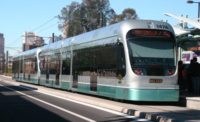Responsiveness. A single word characterizes 2018 for the Nevada Dept. of Transportation (NDOT), the ENR Southwest Owner of the Year.
On the micro level, the department employs nearly 2,000 while maintaining and inspecting the state’s highways and byways. On the macro level, NDOT manages an annual budget of more than $1.2 billion while coping with ever-changing major projects in Las Vegas. Nevada traffic has nearly tripled in the last 15 years to a statewide total of more than 27 billion miles travelled in 2018 thanks to robust population increases and tourist activity.
NDOT was also selected by the ENR regional editors as Owner of the Year in 2012. Since that time, the organization has nearly finished rebuilding many integral aspects of the Las Vegas freeway system as well as creating new roadway options. Recent work will reach a significant milestone when Project Neon phase 1 is completed later this year. At $596 million, Project Neon is the most expensive transportation project in the state’s history and will create a 3.7-mile stretch of Interstate 15 from Sahara Avenue to the U.S. Highway 95 “spaghetti bowl” interchange.
Additionally, NDOT and other regional stakeholders in 2018 completed 15 miles of Interstate 11 from Las Vegas to U.S. 93 past the Arizona state line. This $318-million project is the first new interstate highway in decades.
Northern Nevada has a fair share of highways as well, but preplanning is underway for the re-imagining of Reno’s spaghetti bowl, with construction anticipated to begin after 2020, a major undertaking involving the area’s international airport.
Accomplishing these feats while keeping the state’s highways functioning—as well as serving one of the world’s largest tourist destinations—hinges on a single word: responsiveness.
NDOT’s responsiveness is clearly evident in its partnerships with contractors, says Corey Newcomb, division manager at Las Vegas Paving. Newcomb points to the department’s efforts to integrate contractors’ ideas to make projects better even if that means changing the schedule.
“NDOT is great to work with. When they set up what they want the phasing to be in planning, they don’t know the resources, so we take an aggressive approach, and we may break phasing. They are very open to it, and we still get the job done early and at contract cost,” says Newcomb.
Project Management
Although NDOT is a large state agency, its staff is dedicated to putting results first, says Dale Keller, NDOT’s assistant chief of project management. “It’s everybody from the operators and maintainers and district staff. We are all committed to doing what’s best for the state of Nevada.”
The department’s management of project assignments supports this approach, Keller says. NDOT’s “cradle to grave” attention to project management allows department staff to make decisions independently and cut through red tape.
“We now have an open forum, and it can be contentious, but we feel that is the best way to find out what is important to the community and what they need.”
– Dale Keller, NDOT Assistant Chief of Project Management
“At NDOT, project managers have all of the responsibility and none of the supervision,” he says.
The flexible nature of NDOT project managers also require them to be the public face of projects large and small. Keller says over the past decade, NDOT has amplified the public outreach process, resulting in better projects and happier residents.
“We now have an open forum, and it can be contentious, but we feel that is the best way to find out what is important to the community and what they need,” he says.
Keller, who also served as project manager for Project Neon before recently returning to Carson City, says the department ratcheted up public outreach for that project and the approach is now a model for all major NDOT projects.
For example, John Taylor, senior engineer at Jacobs, says planning for Reno’s spaghetti bowl work has included more than 100 stakeholder meetings. And, as a testament to NDOT’s responsiveness, a southbound exit ramp from Reno-Tahoe International Airport will be preserved after stakeholders raised concerns.
“The community spoke and said that was an important piece of infrastructure and the department responded and responded appropriately to the voice of the community, and that is their charge,” he says.
Technology and Innovation
Responsiveness can also inspire innovation and encourage an organization to embrace technology. NDOT’s growing use of aerial drones and its pursuit of new technologies to move people has enhanced the efficiency of its inspections, mapping and roadways.
With the use of the department’s two aerial drones as well as mapping software, NDOT’s mapping and stormwater personnel can complete tasks in hours rather than weeks, says Tony Illia, public information officer at NDOT.
“Drones additionally can access hard-to-reach areas for maintenance inspections, including pipe inlets, underground culverts, bridges and detention basins. We can quickly and efficiently catalog condition issues such as blockages, defects and cracks via video and photographs, which ultimately helps prioritize expenditures and repairs while saving time and personnel,” Illia says.
On the road, NDOT seeks innovative ways to inform drivers. As part of Project Neon, 42 active traffic management signs—the largest of which are 12 ft by 77 ft—inform drivers of detours, crashes, changing speed limits and traffic restrictions. A similar system in San Diego reduced serious crashes by 46% and overall crashes by 20%, Illia says, adding that most incident reductions occurred when non-commuters make up a higher proportion of drivers. More than 42 million visitors came to Las Vegas in 2018, with approximately 70 percent driving during their trip, according to data from the Las Vegas Convention and Visitors Authority.
Another step forward was NDOT’s trial utilization of Waycare along Interstate 15 through Las Vegas. This new predictive mobility technology combines in-vehicle information, city data and analytics to calculate preventative measures at high-risk incident areas. Illia says the predictive technology cut primary crashes by 17% along an approximately two-mile-long stretch of south Interstate 15 in Las Vegas through warnings on freeway dynamic messaging boards coupled with a more visible law enforcement presence.
Nationally, NDOT also actively supports technological innovations. The department recently worked with the Federal Highway Administration, Minnesota Dept. of Transportation and the Michigan Dept. of Transportation to integrate mobile observation elements to fleet-vehicle technology. The system adds ancillary sensors to vehicles in order to collect data including air pressure, air and surface temperature, spreader rate and materials, windshield wiper status and rate, and relative humidity. NDOT’s goal is to make real-time road weather information available through information systems like the 5-1-1 system.
Although Kristina Swallow, current NDOT director, only recently began work at the agency, the former director, Roy Malfabon, was a 35-year NDOT veteran. Swallow previously served as program director for the city of Las Vegas Public Works, but she embraces the past when looking to the future.
“I’m excited to see the department recognized for its great work for improving safety, while also increasing mobility, enhancing efficiency and creating greater connectivity,” Swallow says.







Post a comment to this article
Report Abusive Comment